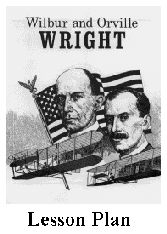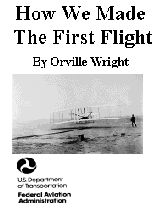 ur
presentations are geared to students between the ages of 10 and 14,
although we have worked -- and worked well -- with both younger and older
audiences. We prefer to spend a day or more at each school, meeting with
one or two classes at a time, rather than addressing large assemblies.
Each session lasts between 1 and 2 hours, depending on your schedule and
the number of classes you want us to address. ur
presentations are geared to students between the ages of 10 and 14,
although we have worked -- and worked well -- with both younger and older
audiences. We prefer to spend a day or more at each school, meeting with
one or two classes at a time, rather than addressing large assemblies.
Each session lasts between 1 and 2 hours, depending on your schedule and
the number of classes you want us to address.
We've found that kids get much more out of these visits
if the teachers do some preparatory work, explaining what the Wright
brothers did and the overall importance of their work. To assist you in
this task, we've adapted a lesson plan
on the Wrights that was prepared by the Civil Air Patrol and is offered
through the Federal Aviation Administration
(FAA). You can download both the lesson plan and the student
activity booklet by right- clicking on the thumbnails to the right.
Choose "Save
Target As" (in Explorer) or "Save Link As" (in Navigator) from the pop-up
menu that appears. Save the ZIP file to a folder on your hard drive. These
are large files, so they may take a while to download. They each
unzip into a MicroSoft Word .doc file. Print them out,
then choose the information and the activities you would like to cover
with your class. Note: For additional ideas on curriculum,
visit the Franklin Institute's "Teacher's Zone," where
they have gathered an astounding array of aviation education materials,
sources, and links from both the United States and Britain. Here's the
link: http://www.fi.edu/flights/teacher/index.html
When we come to your school, you can expect us to
emphasize these parts of the Wright story: |

Right-click on the image to download a zipped file for
the Lesson Plan. This file is about 800K.

Right-click on the image to download a zipped file for
the Activities Book. This file is about 6 megs.
|
Social Studies
- The Wright Brothers did not invent the airplane, they
invented a revolutionary system to control an airplane. The idea of an
airplane was old as the hills, but they made it work.
- The Wright Brothers worked at a time when science
first began to affect ordinary people's lives in a powerful way. In
1903, when they made their first powered flight, Henry Ford made the
first Model T automobile. Thomas Edison (inventor of the light bulb),
Alexander Graham Bell (inventor of the telephone), and Albert Einstein
(whose work led to the atomic bomb) also worked during this period.
- The airplane affects our lives by bringing people and
ideas closer together. Today, you can take commercial airlines around
the world in a few days. Some military jets can fly around the world
in less than a day. And the Space Shuttle orbits the earth in less
than an hour.
|
Click on a
photo to enlarge it.

"The Wright brothers did not invent the
airplane!"

"They invented a control system that made it
work."
|
Science
- An airplane flies because the pressure of the air on
the wings lifts it off the ground, similar to the way the wind lifts a kite.
- Once an airplane is in the air, a pilot has to
balance to keep it upright and pointed in the direction he wants to go
-- "Pointy end forward and dirty side down," as the saying
goes.
- The Wright Brothers invented control surfaces that
enable a pilot to balance an aircraft -- movable wings to roll
an aircraft from side to side, an elevator to pitch and
aircraft up an down, and a rudder to yaw the nose right an
left. Every aircraft flying today still has roll, pitch, and yaw
controls.
|

"The wind lifts the wings like a kite."

"Pointy end forward; dirty side down."
|
Character Development
- The Wright Brothers didn't just have an idea and they
went out and built an airplane that flew. They worked for seven years
from 1899 to 1905 before they finally had an aircraft that flew well.
During that time, they had many failures - and many crashes. But they
kept going.
- The Wrights found it easier to keep going because
they had the support of their family. Their father, Bishop Milton
Wright, always encouraged his children to explore their world. He was
proud of what he sons were doing, even when other people told him it
was foolish and dangerous.
- The Wright Brothers weren't daredevils. Their flights
were very dangerous, but they tried to reduce the risk by starting
with short, brief flights and gradually flying farther and longer. The
best test pilots today still follow their example.
|

"It took the Wrights seven years and hundreds of
crashes to perfect the airplane. |
| We also provide important follow-up
information and activities. When children become excited about a subject, they want
to know more. So we offer the means for them to learn as much about the
Wright Brothers, early aviation, and aeronautics as they would like to
know.
This web site, first-to-fly.com, is the largest single source
of information on the Wright Brothers on the Internet. It's unique
"layered" presentation allows a student to dive into any topic
as briefly or as thoroughly as their interest dictates. Our special
hands-on section, Will and Orv's
Workshop, provides plans and instructions for building some of the
simple flying machines that we bring to your school, such as the 1878
Wright Bat or a 2/3-scale model of the 1899 Wright Kite. We're currently
working on a flying model of the 1902 Wright Glider that kids can make
from scraps of Styrofoam. And we're preparing a long list of reading materials,
instructions for how to use interlibrary loan (to obtain books that aren't
in their local library), aviation museums, and links to other early
aviation web sites.
We'll make sure that each student has a map of our site
before we leave your school. And we'll leave your school library a
"disk-based web" -- our web site on a CD-Rom -- so students
without computers at home can still access our information. |

If our demos ignite your students' interest, they will
want to know more. In this special FAA pamphlet, Orville Wright tells in
his own words how he and his brother Wilbur invented the airplane.
Right-click on the image to download the 1.5 meg zipped file. |